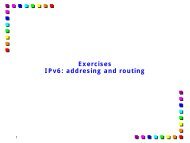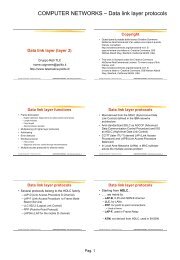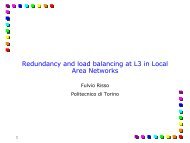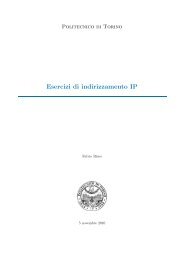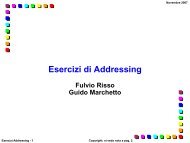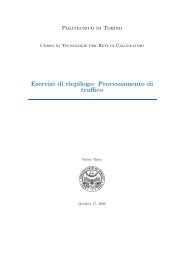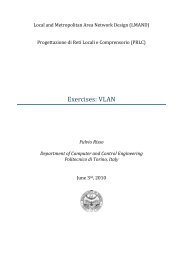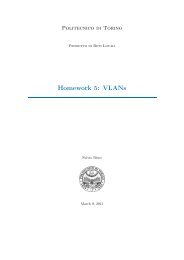High-Speed Policy-based Packet Forwarding Using Efficient Multi ...
High-Speed Policy-based Packet Forwarding Using Efficient Multi ...
High-Speed Policy-based Packet Forwarding Using Efficient Multi ...
Create successful ePaper yourself
Turn your PDF publications into a flip-book with our unique Google optimized e-Paper software.
to obtain first the overlapping intervals d: in the d dimension.<br />
From these we create the non-overlapping sets 0:.<br />
The non-overlapping intervals are created by a scan of the<br />
overlapping intervals from lower to higher co-ordinates in<br />
the d dimension. The procedure is:<br />
1. doforalli<br />
2. Sort the set of overlapping intervals d{ into ascending<br />
sequence of their starting points.<br />
3. If an interval starts or ends, generate Us for previous<br />
interval. Store the interval and pointer to actions for<br />
highest priority rectangle that overlaps this interval” If<br />
newly created interval, and its previously stored adjacent<br />
interval point to the same rectangle, merge these<br />
two intervals. Since a new interval 0;’ is created, at<br />
most, when an overlapping interval begins or terminates,<br />
the size of this new set 0: is Kf 1 the sizes are O(1). Clearly,<br />
in this case the worst case execution time is O(ls + logn).<br />
Of course, we cannot count on such a good arrangement of<br />
intervals. However, we can make this happen by introducing<br />
some “virtual” intervals using a technique used in computational<br />
geometry to speed up searches in multiple ordered<br />
lists [7, 8]<br />
When we perform a search on the list at level say i, the<br />
information we get is that the given d lies in an interval<br />
Q. When we next search the lists at level i + 1, instead of<br />
searching through all the intervals, we can use the information<br />
learned in the previous search and search amongst only<br />
those intervals that fall in the range given by q. While this<br />
may improve the average case performance, unfortunately,<br />
the worst case is not affected by this heuristic. This is because<br />
at level i + 1 there may be O(n/ls) intervals which fall<br />
within the range determined by 0: and this can happen at<br />
all levels. Hence, an O(log(n/Zs)) = O(log n) search may be<br />
needed at every level.<br />
Now suppose we introduce “virtual intervals” at levels<br />
i < Zs in the following manner. There are Nl, intervals<br />
at level Is. Let us also denote by y:“, yk . ., the boundary<br />
points that demarcate the Nl, intervals in the d dimension<br />
at level 1s. There are 2 * iVl, such points at most. We replicate<br />
every other point at level Zs to level Zs - 1, i.e 2 * Nl,<br />
points are moved to level Zs - 1. The points that were propagated<br />
together with the points defining the original intervals,<br />
define the intervals at level Zs - 1. These are stored as nonoverlapping<br />
intervals at level 1s - 1. Next we take all the<br />
intervals now at level Is - 1 and their associated points and<br />
212



